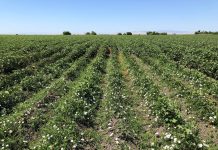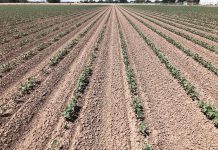The overall objective of this research is to evaluate field screening location(s) with a moderate to high level of sustained Verticillium wilt inoculum to provide location(s) for field screening of cotton germplasm of interest in CA Cotton production. The aim of the work will be: (1) to sustain a relatively small location (approximately 0.5-1 acres) at the West Side REC where we can maintain a Verticillium wilt population for field screenings to identify relative susceptibility of newer commercial varieties of interest for California cotton production, and for screening of experimentals from both commercial breeders or seed companies and those from USDA-ARS or other public breeding programs; and (2) to support evaluation of relative Verticillium wilt levels in cultivars being tested in the FOV race 4 screening location(s).
Some of the evaluations have either not been done (West Side REC) for 2019 or have not yet been summarized (Tulare County site) at the time of preparation of this report since the best time for evaluations of this type are generally mid- to late-summer. Results from the 2019 field evaluations will be summarized when data is available.
Summary from 2018
Tulare County Location:
All entries grown in the FOV race 4 screening trials were grown at a location with Verticillium present, which also turned out to be a location that had race 4 FOV present. The screening for Verticillium was still done at this location since the plantings were in place and we considered it to be useful information, and the Verticillium screening was done on a minimum of 5 plants per entry per replication, for a total of 15 plants per entry to rate for incidence (of plants with Verticillium evidence in the stem – vascular staining about 1/4 to 1/3 of the way up the stem, as compared to root vascular staining evaluations for FOV).
West Side REC location:
Evaluations were done at a site at the West Side REC of the University of CA where we planted small plots for evaluation. The screening for Verticillium was done at this location on 7 plants per entry per replication, for a total of 21 plants per entry to rate for incidence (number of plants with Verticillium evidence in the stem – vascular staining about 1/4 of the way up the stem, as compared to root vascular staining evaluations for FOV).
The overall objective of this research is to evaluate field screening location(s) with a moderate to high level of sustained Verticillium wilt inoculum to provide a location for field screening of cotton germplasm of interest in CA Cotton production. The aim of the work will be: (1) to sustain a relatively small location (approximately 1 acre in multiple variety trials) at the West Side REC where we can maintain a Verticillium wilt population for field screenings to identify relative susceptibility of newer commercial varieties of interest for CA Cotton production, and for screening of experimentals from both commercial breeders or seed companies and those from USDA-ARS or other public breeding programs; and (2) to support evaluation of relative Verticillium wilt levels in cultivars being tested in the FOV race 4 screening locations.
The intent of continuing this work on a relatively small scale, and with data reported from both West Side REC and field trial locations where we also are doing Fusarium race 4 field screening is to develop information on Verticillium wilt incidence in currently-grown and possible future cultivars of interest for California cotton production. Verticillium wilt incidence was evaluated in 5 plants per field replication at each field site. The intent is that UC and USDA-ARS investigators as well as seed company representatives and breeders could use this information in determining the relative need for follow-up evaluations and screening efforts for Verticillium wilt susceptibility as they advance cultivars through their selection processes. The charts attached to this brief report give an indication of the levels of Verticillium seen during the current year evaluations for the broad mix of cultivars.
Verticillium wilt incidence evaluations were done on a large collection of experimental Pimas and Uplands that were included in our Uplands Advanced Strains trial, plus experimentals submitted by seed company representatives or breeders, plus public breeder entries in the RBTN (Regional Breeder Testing Network) evaluations coordinated by Ted Wallace of Mississippi State University in cooperation with the USDA-ARS. Figures 1 through 5 show Verticillium incidence in commercial Upland/Acala & advanced experimental Uplands at Tulare County site in 2018 field evaluations. The five graphs show data for over 100 entries plus three check varieties. The check varieties were evaluated for consistency of data across field replications, and generally incidence of verticillium was evident across all three field replications in most entries. Check varieties included were: DP-340 Pima, Phy-888RF Pima and Mon-109-C7 Experimental Pima.
Data for the Tulare County site and the West Side REC site for 2018, and similar
results will be prepared when 2019 data is available on the UC Cotton Website.
Verticillium incidence is generally higher in Upland varieties than in Pima varieties. However, there are examples of very low incidence, or even zero incidence cultivars in both Upland and Pima data particularly at the Univ CA West Side REC site, but in some cases
also at this one Tulare County site. It was interesting that the experimental
Egyptian Pima cultivars worked with in recent years and in crosses did not
appear to be susceptible to Verticillium, at least at 2018 evaluation sites. Similar
data will be collected from two sites in 2019 and made available after analysis.
The intent of this work is to provide it to seed companies as a means of identifying materials that may require some additional evaluations for Verticillium susceptibility as they move forward in their breeding programs.




















